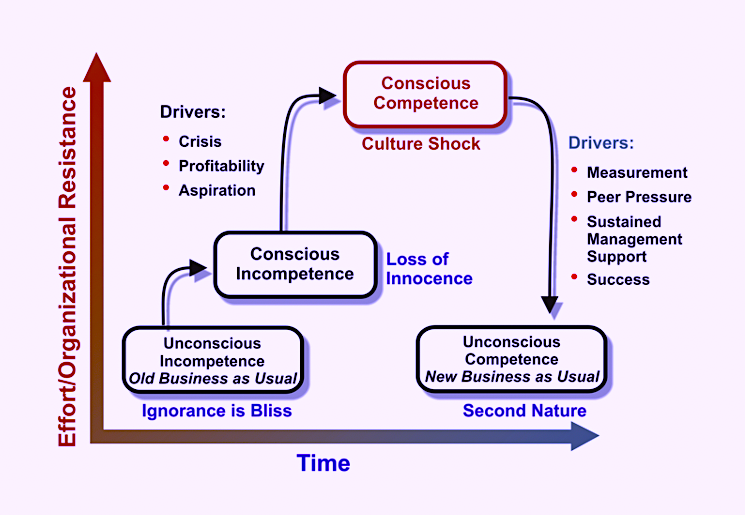My last article for The RAM Review (April 4, 2021, see link below) explored the important role middle managers can play in achieving transformational change. In it, I discussed the concept of psychological inertia. In physics, we refer to a force that has both rate (magnitude) and direction (a vector). A body in motion tends to remain in motion at the same rate and/or in the direction in which it is moving, unless another force acts upon it to change the rate and/or direction to establish a new or modified vector. If that body has no rate or direction of movement, it is at rest and will remain at rest unless an adequate force is applied to initiate movement. That’s inertia 101.
PSYCHOLOGICAL INERTIA: RESITANCE TO CHANGE
Psychological inertia is conceptually similar to physical inertia, but it applies to the behaviors of individuals or groups. People are, for the most part, very resistant to change. If these behavioral vectors, or norms, are effective and working well, we want to perpetuate them (“if it ain’t broke, don’t fix it”). If, for some reason, they’re not effective, we need change management to establish new norms. To drive change, ineffective existing norms must be acted upon with a sufficient force to establish new norms that are effective.
Click Here To Read The Referenced April 4, 2021, Article
“Change Management From The Middle Out”
There are plenty of reasons why people resist change. In general, though, it’s because they don’t understand why the change is being made and and/or how it will affect them. The uncertainties associated with change can fuel numerous feelings of uncertainty, insecurity, and fear, including, among other things, those associated with:
-
-
-
- reduced job security
- loss of control or authority
- reduced status or recognition
- reduced compensation
- lacking the qualification/skills
to do things the new way - insufficient time.
-
-
THE PROGRAM OF THE DAY
Unfortunately, most transformational change initiatives fail. RAM initiatives are no exception. One of the most common failures is the inability to achieve the type of sustainable change that permanently alters behavioral vectors. It works like this: We come in with a “program” and force the issue. But when the eyes of leadership are turned to a the next “program,” team members tend to gravitate back to their old vectors and their old norms. Let’s explore this phenomenon in more detail.

Fig. 1. Sustainable change management requires a “new business as usual.”
Consider the graphic in Fig. 1. The X-axis represents “time;” the Y-axis represents “effort and organizational resistance,” i.e., psychological inertia. In the lower left-hand corner of the graphic, we have the current “business as usual.” This is the organization’s current behavioral vector, or “norm.” In it, the organization is in a state of “Unconscious Incompetence,” where ignorance is bliss. Suppose that a transformation-minded leader learns of a better way to conduct this aspect of the business and, in turn, make the plant more reliable, less costly to operate, safer, and/or more environmentally responsible. At this point, the organization enters the second box, which is a state of “Conscious Incompetence,” where we’ve lost our innocence and feel a responsibility to eliminate the deficiency.
A PREDICTABLE FAILURE PATTERN
The transformational leader(s) of an initiative to improve a particular inadequate business process typically will sell it to senior management; scope it out; conduct some training; purchase hardware, software, or services required to implement the new program; get things rolling; declare success; then move onto the next transformational initiative. This brute-force approach to change rarely achieves sustainable change because it puts the organization into a state of culture shock and invokes all of the previously discussed uncertainties, insecurities, and fears.
In the early stage of change initiative, the organization is in a state of “Conscious Competence.” Although the organization is executing in accordance with the new process, a great deal of effort is required: It’s a psychologically taxing process. Our objective is to get to the box on the lower right-hand side of Fig. 1 (“Unconscious Competence”), where executing the improved process is second nature. The organization has a “new business as usual” that is sustainable. Without sustained leadership, the organization predictably drifts back into comfortable practices that don’t require much effort, i.e., the old business as usual.
ACHIEVING SUSTAINABLE CHANGE
Most transformational-change initiatives go awry due to a lack of sufficient coaching, mentoring, encouraging, and cajoling from the transformational leadership team. All too often, these innovative leaders move onto the next shiny object before they’ve achieved the new business as usual. Making matters worse, when the organization drifts back into an old business as usual mode, it’s difficult to restart a change initiative, even if the proposed new business as usual is truly valuable. When a leader tries to restart a stalled transformational change, the organizational will collectively say, “We tried that. It doesn’t work,” which only increases the existing level of resistance.
If you’re transformation-minded, go all the way or don’t go at all. Transformation is truly an all or nothing proposition. Also, make sure you understand the need-drivers for each of the key stakeholder groups in your organization. That way, you can answer the question of “what’s in it for me” (WIFMs), which will be the topic of my next article for The RAM Review..TRR
ABOUT THE AUTHOR
Drew Troyer has over 30 years of experience in the RAM arena. Currently a Principal with T.A. Cook Consultants, he was a Co-founder and former CEO of Noria Corporation. A trusted advisor to a global blue chip client base, this industry veteran has authored or co-authored more than 250 books, chapters, course books, articles, and technical papers and is popular keynote and technical speaker at conferences around the world. Drew is a Certified Reliability Engineer (CRE), Certified Maintenance & Reliability Professional (CMRP), holds B.S. and M.B.A. degrees, and is Master’s degree candidate in Environmental Sustainability at Harvard University. Contact him directly at 512-800-6031 or dtroyer@theramreview.com.
Tags: reliability, availability, maintenance, RAM, change management, organizational change, workforce issues



